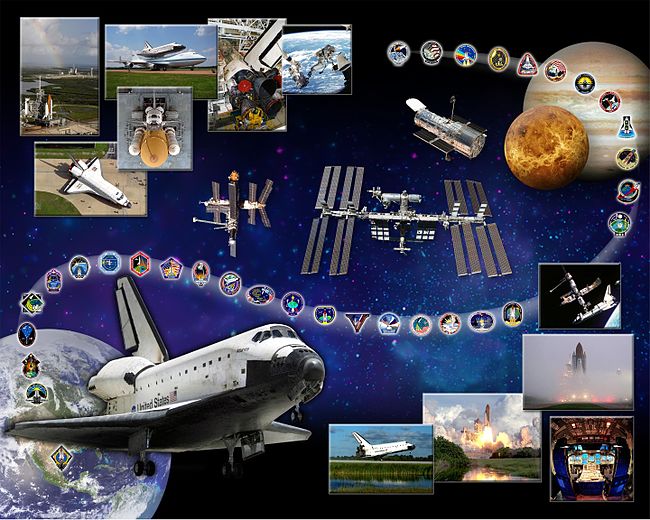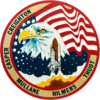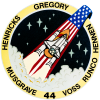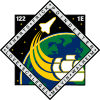Space Shuttle Atlantis
The space shuttle Atlantis (NASA designation: OV-104) was one of the shuttles in the fleet belonging to the National Aeronautics and Space Administration (NASA). It was the fourth operational shuttle to be built. Following the destruction of the Challenger and Columbia ferries, she was one of three fully operational ferries in the fleet.
It is also the last of the shuttles to be retired, after its STS-135 mission, which was intended to install an additional module to the International Space Station, as well as supplies for a year. The ferry's name comes from the first vessel of the Woods Hole Oceanographic Institute (Massachusetts), which conducted ocean research from 1930 to 1966.
History
Atlantis made its maiden flight in October 1985, conducting classified military activities, one of only five such flights. In 1989, the shuttle launched two planetary probes, Magellan and Galileo, into orbit, and in 1991, it deployed the Compton Gamma Ray Observatory.
In early 1995, Atlantis made seven direct flights to the Russian space station Mir. On her second trip, she delivered a docking module and on subsequent flights, exchanges between astronauts. From November 1997 to July 1999, the shuttle Atlantis underwent a series of modifications, with a total of 165 changes, one of them being the Multifunctional Electronic Display System. From that moment on, he carried out six more missions, all related to assembly activities of the International Space Station (ISS).
In October 2002, Atlantis and its crew of six astronauts completed an eleven-day mission to the International Space Station, including three spacewalks.
NASA scheduled the 27th Atlantis mission for September 2005. However, it was decided that it was unsafe to fly and the launch window was missed, due to complications during the launch of Discovery on STS-114 and the suspension by NASA of all shuttle launches. Atlantis was designated as the STS-300 rescue orbiter for the STS-114 mission. Atlantis was scheduled to fly on the STS-121 mission, but it was decided that Discovery would carry out the mission.
After a layover of four and a half years, Atlantis returned to space on mission STS-115, carrying segment P3/P4 and solar panels for the ISS. The next flight of Atlantis was scheduled for STS-117, but due to a hailstorm on February 26, 2007, the launch was delayed until June 7, 2007.
In early 2006, NASA announced its intention to retire Atlantis on May 14, 2010, after STS-132, and that it would be used as supply parts for Discovery and Endeavor until the end of the program. of the Space Shuttle in 2010. Its early retirement was justified by the need to avoid an expensive commissioning process scheduled for 2008.
Her last flight was for the STS-135 mission, which lasted 13 days, with a crew of 4 astronauts, in which she transported provisional reserves for one year to the International Space Station (ISS), from its launch on July 8 until its landing on July 21, 2011, ending its service to be retired and put on display at the Kennedy Space Center in Florida.
With the last flight of Atlantis the era of the Space Shuttles closes after 30 years of operation of the program, leaving NASA dependent on the Russian Soyuz spacecraft, for space launches in the immediate future.
Flights
The space shuttle Atlantis has completed 33 missions, staying in space for 293 days, completing 4,648 orbits and a total distance of 194,168,813 km, prior to the STS-135 mission.
Table of missions
| Date | Name | Notes |
|---|---|---|
| 3 October 1985 | STS-51-J | Atlantis' first mission. Mission dedicated to the Department of Defense. |
| 26 November 1985 | STS-61-B | orbit of Morelos II, AUSSAT-2 and SATCOM KU-2 communication satellites. |
| 2 December 1988 | STS-27 | Mission dedicated to the Department of Defense. |
| 4 May 1989 | STS-30 | Fit in orbit of the Magellan probe. |
| 18 October 1989 | STS-34 | orbit of Galileo probe. |
| 28 February 1990 | STS-36 | Mission dedicated to the Department of Defense. |
| 15 November 1990 | STS-38 | Mission dedicated to the Department of Defense. |
| 5 April 1991 | STS-37 | Gamma Compton Ray Observatory orbit. |
| 2 August 1991 | STS-43 | Launch of the TDRS-5 satellite. |
| 24 November 1991 | STS-44 | Mission dedicated to the Department of Defense. |
| 24 March 1992 | STS-45 | First mission of ATLAS (Atmospheric Laboratory for Applications and Science). |
| 31 July 1992 | STS-46 | Launch of the EURECA and TSS satellite. |
| 3 November 1994 | STS-66 | Third mission of ATLAS. |
| 29 June 1995 | STS-71 | First link with Mir space station. |
| 12 November 1995 | STS-74 | Delivery of the accompanying module to the Mir. |
| 22 March 1996 | STS-76 | Meeting with the Mir, transfer of crew from Shannon Lucid. |
| 16 September 1996 | STS-79 | Meeting with the Mir, transfer of crew from Shannon Lucid and John Blaha. |
| 12 January 1997 | STS-81 | Meeting with the Mir, crew transfer of John Blaha and Jerry Linenger. |
| 17 May 1997 | STS-84 | Meeting with the Mir, crew transfer of Jerry Linenger and Michael Foale. |
| 25 September 1997 | STS-86 | Meeting with the Mir, transfer of crew of Michael Foale and David A. Wolf. |
| 19 May 2000 | STS-101 | International Space Station mounting mission (ISS). |
| 8 September 2000 | STS-106 | International Space Station mounting mission (ISS). |
| 7 February 2001 | STS-98 | International Space Station mounting mission (ISS), transporting the Destiny module. |
| 12 July 2001 | STS-104 | Mounting Mission of the International Space Station (ISS), transporting the Quest module. |
| 8 April 2002 | STS-110 | International Space Station mounting mission (ISS), transporting the S0 segment. |
| 7 October 2002 | STS-112 | International Space Station mounting mission (ISS), transporting the S1 segment. |
| 9 September 2006 | STS-115 | International Space Station mounting mission (ISS), transporting P3 and P4 segments. |
| 8 June 2007 | STS-117 | International Space Station assembly mission (ISS), transporting S3 and S4 segments. |
| 7 February 2008 | STS-122 | International Space Station mounting mission (ISS) (Columbus Laboratory). |
| 11 May 2009 | STS-125 | Fourth and last service mission to the Hubble Space Telescope, takes you two new instruments, the Cosmos Origen Spectrograph and the Wide Field Camera 3. A guide sensor, six gyroscopes, and two battery modules are replaced. |
| 16 November 2009 | STS-129 | International Space Station (ISS) assembly mission (ELC-1/ELC-2). |
| 14 May 2010 | STS-132 | International Space Station (ISS) Mounting Mission (Mini-Research Module 1) |
| 8 July 2011 | STS-135 | International Space Station mounting mission (ISS). Last mission of the space shuttle program. |
Tribute and Mission Badges
| NASA Tribute by Atlantis Space Shuttle | |||||||
|---|---|---|---|---|---|---|---|
| Mission badge for Atlantis mission flights | |||||||
STS-51-J | STS-61-B | STS-61-G* | STS-27 | STS-30 | STS-34 | STS-36 | STS-38 |
STS-37 | STS-43 | STS-44 | STS-45 | STS-46 | STS-66 | STS-71 | STS-74 |
STS-76 | STS-79 | STS-81 | STS-84 | STS-86 | STS-101 | STS-106 | STS-98 |
STS-104 | STS-110 | STS-112 | STS-115 | STS-117 | STS-122 | STS-125 | STS-129 |
STS-132 | STS-135 | ||||||
* Mission canceled after the Challenger shuttle accident.
In popular culture
- In the movie Deep Impactthe crew uses the Atlantis to reach the mission ship, the Messiah.
- In the video game The DigA nameless shuttle participates in the mission to shoot the asteroid. However, the demo of the game mentions the name "Atlantis".
- In the movie Armageddon, the Atlantis space shuttle is destroyed in orbit at the beginning of the film due to a meteor shower.
- In the movie "SOS Equipo Azul" is the main vehicle. A group of young superdotados who attend a space camp are accidentally thrown into space when they performed the shuttle engine test.
Contenido relacionado
Echinopogon
Alternator
Geography of the Republic of the Congo




































